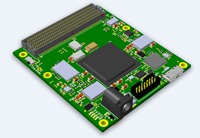VHDL stands for VHSIC Hardware Description Language. VHSIC stands for Very High Speed Integrated Circuit. VHDL is simply a hardware description language(HDL) used in describing electronic systems in terms of theirbehavior and structure, at the system, component, and board levels.
VHDL started out as a US government project in 1980 as a form of documentation language. It later on became IEEE standard 1076.1 in the year 1987 with an update in 1993. What makes VHDL stand out from other hardware description languages is that it is defined completely under LRM or the Language Reference Manual and conforms to international standards. In contrast, other hardware description languages are defined by the behavior of tools using them in an ad hoc way.
VHDL supports structural description, behavioral description, and generic description of hardware. Structural description involves circuit creation by means of logic gates connections. Behavioral description meanwhile refers to “describing” logic behavior of components in a circuit by using small programs. Generic description involves describing components and their parameters.

VHDL is a hardcore type of hardware description language and is typically used for some serious processor design. It differs fromVerilog, anotherhardware description language, in the sense thatVHDLis more of a specification language and has a very “exact” nature wherein it approximates the function you intended to write. In contrast,Verilogonly assumes whatever you type is final and so requires additional care to avoid bugs in the syntax.
VHDLis said to be helpful in FPGAs or field program gate arrays. These are digital logic devices configured for a specific digital function.VHDLcan also be used on ASICs or application specified integrated circuits, which are silicon chips designed for a specific purpose.VHDL, being an international standard (IEEE), has high portability and versatility and is very simple to develop.


 My Message
My Message
 Suggestions
Suggestions













sergio
2017/2/19 14:08:33
Awesome post. Like it very much.